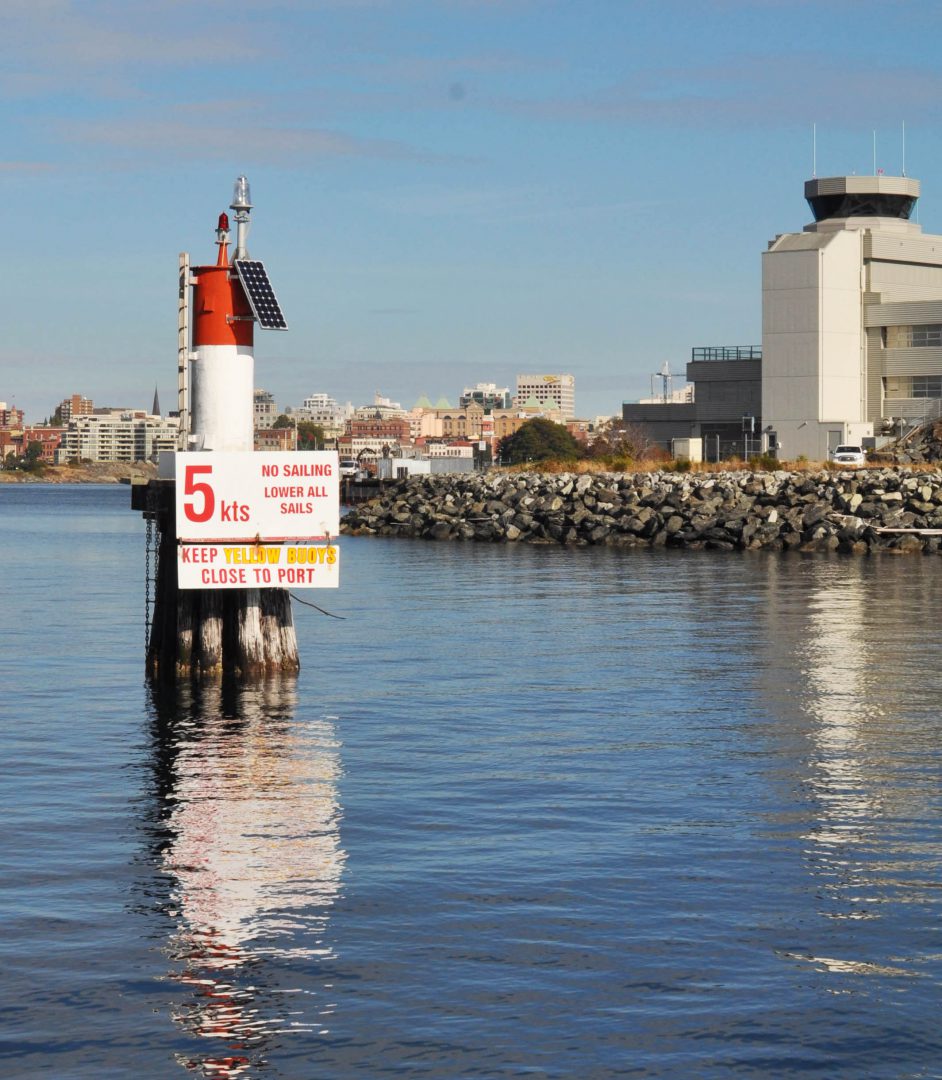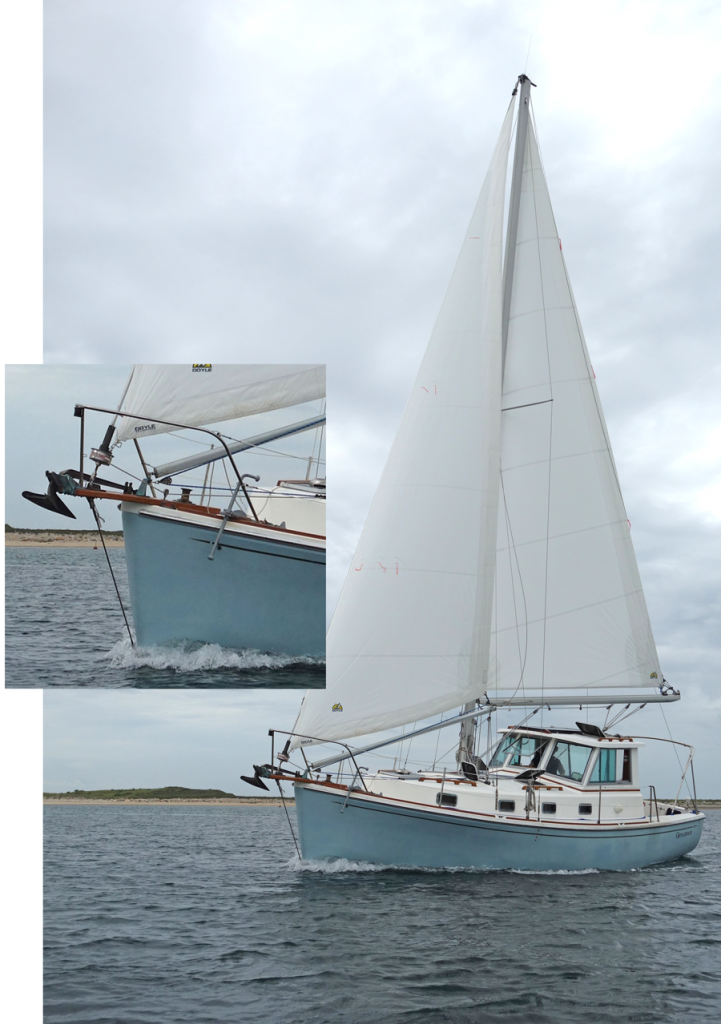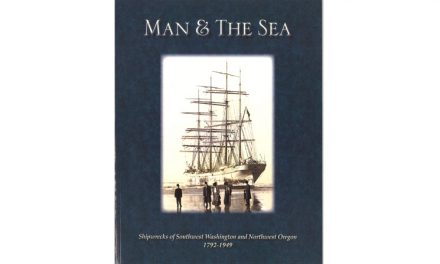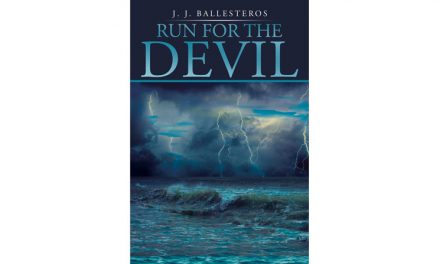
This was the first of several such aids to navigation we passed heading into Canada’s Victoria Harbour, on Vancouver Island, in 2012. The reason for keeping close to the yellow buoys was to avoid a collision with floatplanes. As Southern California sailors just up from Mexico, this was all new to us. Heading further north during the following year, it soon became our normal. –Michael Robertson Send michael_r@goodoldboat.com your favorite hi-res photo of an aid to navigation, be creative. If we use your pic in Good Old Boat magazine I’ll send you a Good Old Boat cap or shirt.
UNSAFE AND IRRESPONSIBLE
I am dismayed that you would publish (and in-effect endorse) Tom Alley’s installation of an “OUTDOOR USE ONLY” propane stove for his Alberg 35 (“A New Galley Stove,” Good Old Boat, January 2018).
Why would Good Old Boat approve this feature article for publication, and in doing so reassure others that this is an acceptable installation?
I contacted the manufacturer [of the stove Tom purchased], and learned there are no safety valves for the stove-top burners. The instructions for this stove clearly state that this stove/oven is NOT to be used in any enclosed facilities, including a boat. Further, nothing is mentioned in your “Propane Safety” inset box concerning the requirement of having safety valves (thermocouples) for all propane stoves used in boats. Featuring this re-fit improperly encourages others to consider this cheap and dangerous installation.
It is simply foolish to use this stove indoors. My harsh criticism is only meant to emphasize that this installation is just plain wrong. I would expect that Tom Alley, who is a Power Squadron Education Officer — or you — to follow-up on this article by telling your readers, “don’t try this at home (on your boat), it could be dangerous to your health.”
–Denis Vogel, Madison, Wisconsin
Thank you for your feedback Denis. You are not the only reader to bring this up. We’re running your letter here and another letter in the March issue of Good Old Boat so that this message reaches as many readers as possible.
To be clear, it was not our intent to imply that Tom’s budget alternative to cooking aboard is on par, safety-wise, with an ABYC-approved marine stove. And two other points are worth noting. First, this is a straight R&R as the stove that was installed originally aboard this half-century-old boat was also a camp stove. Second, Tom wisely ditched the regulator that came with this stove and used the one attached (outdoors) to his propane tank. –Eds.
TOM ALLEY WEIGHS IN
The setup aboard Tomfoolery when I became her owner was a camp stove with a 1-pound propane bottle stored in a drawer in the galley. There was no propane locker, no propane sniffer, and no solenoid/safety shutoff. And all of this was right next to a gasoline engine! We had a bilge blower, but the only real safety device on board was the operator and his/her nose. It had been like this for 31 years. We learned to be careful, as propane and gasoline are similar in terms of behavior and risk. Multiple boat fires in our marina (one of them fatal, all caused by gasoline) ensured we remained vigilant until such time as we could improve things. As we were a young family and only doing the occasional overnight, we didn’t cook much, if at all, on the boat.
Fast forward some years and we made improvements as the kids grow up and the trips got longer. We upgraded the propane system and connected to a larger tank on-deck (where it is ventilated); we installed a propane solenoid and a propane sniffer; and we replaced the stove (upgraded in function but not necessarily in quality) and moved all high-pressure propane lines outside the boat. A few more years down the road the camp stove is going to wear out (I have no illusions about the longevity of a cheap stove in a marine environment) and we can then replace it with a better, safer model after colleges get paid off. Like most things sailing, this is a journey and we are moving along at a constrained, but deliberate pace.
Another thing I consider is that many product warnings have more to do with liability than with actual risk. (Have you read a box of toothpicks lately?) The outdoor-use-only warning could easily be as much a caution about CO poisoning and oxygen depletion than about explosion risk. (Your readers can rest assured that Tomfoolery has not one, but two working CO detectors mounted in the main cabin and that we use the stove only with ports opened to provide ventilation and we never use it to heat the cabin.) A prerequisite to sailing successfully is having some common sense. One needs to know, and understand, the risks involved. Using a device properly and keeping it maintained is probably more important than an ABYC certification.
—Tom Alley, Good Old Boat contributor
NEW-GEN ANCHORS VS. OLD-SCHOOL ANCHORS
Last month I put it to the readers about new-generation anchors (such as Mantus, Rocna, Sarca, Raya, Manson): Have you (would you?) traded from old to new? Have you noticed a difference? I offered that we use a 66-pound Bruce that has been dependable, yet were money no object, I’d purchase a new-generation anchor in a heartbeat. A big one. Am I alone? Understandably, I got a lot of feedback on this one… –Eds.
Pandora’s box opened have you… I run a high school at sea. We are at sea a lot with several different boats. I am a trusty ole Bruce guy with not as many nights hanging on an anchor as you have, but far more than most people have. I, like you, have stories of a trusty Bruce holding when it should not have on 2 to 1 scope in the deep waters of Catalina Island in California, when 4th of July crowds prevented us from getting closer. And then again in brutal winds as the edge of a hurricane swept by in St. Maarten. And in many more cases that would take too much time to tell, the Bruce never failed us.
Our newest boat is a 76-foot Bruce King custom beauty, a real monster that came with a slightly undersized Bruce and held us as we wandered the Caribbean. She was built with only one roller and while we decide how we want to move to a second anchor without damaging her stunning good looks and custom metal work, we occasionally ponder the newer anchors and all the hoopla about them. Only once has a Bruce failed me and it did so only after it held in sea grass mixed with trash, old anchor lines, and tires that were spread over a sparse rocky/sandy bottom through several squall lines before it finally dragged.
I see more of the new anchors popping up in marinas as we travel, mixed among the slightly rusted older Bruce, CQR, and Delta anchors that adorn the bows of boats around the world. And the advertisements keep rolling out. Videos of straight pulls on beaches and murky waters. And the ads keep rolling out.
In the end, I may pick up one of the shnazzy new anchors to put on the second roller for our new beauty, but I will not change it out for my trusty ole Bruce as my mainstay.
Oh, as a side note, we carry a fantastic Fortress that, with plenty of chain behind it, will hold in sand like King Kong holds on to his true love. We have a Delta that has impressed me over and over. We have several boats in the school and literally hundreds of anchors, but not yet one of the new highly advertised ones.
So, in the end, I am in the same boat as you (sorry, couldn’t help it) with a trusty old hunk of iron that never let me down. I will not likely have a boat that travels internationally (that is under 80 feet in length) that lacks a Bruce on the bow, but I may put one of the new high-tech well-advertised anchors on the spare roller when I figure out how I want that to be set up.
–Capt. Scott Rhoads, www.ultimateadventureacademy.com, Clearwater, Florida
I love our Rocna. We have a 73-pound one attached to an all-chain rode. Its over-kill for our Brewer 44, but it sets fast and we sleep at night. We are currently cruising the Abacos heading south to the Exumas. We anchor out a lot and haven’t dragged once, so far.
–Bill Fiegener, Aquila, Marblehead, Massachusetts
If you can afford it, get a new-gen anchor. The reason that Bruce was so reliable was not because it was a Bruce, but rather because of all the chain that came with it. You will achieve as-good-or-better holding with an equally sized next-gen anchor with 15-feet of chain and rope making up the rest of your rode. Or get a slightly smaller next-gen anchor and stick with the all-chain.
I have two Rocnas, one that’s slightly oversized for my boat, and another that’s slightly undersized. The undersize one is the one I use 99% of the time. The big one gets pulled out for hurricanes and other big storms, in which cases I use both in a dual anchoring scheme.
–Clay Watson, Mobile, Alabama
We sail the Texas Gulf Coast and the bottom is sand, mud, oyster shell, or a mix of these. In the sailing we do, we anchor in one spot that is 15 feet or more depth, but mostly stick with anchorages that are of 12-foot depth or less. We have hung well on Danforths, Deltas, and CQRs. We have drug anchor only once after a 180-degree wind shift when a strong norther blew in. We were expecting the wind shift and prepared properly (we thought) but we drug anyway.
Any anchor will hold on these kinds of bottoms, so long as it is heavy enough, there is sufficient rode/chain, and you seriously follow the basics.
–James Shell, The Woodlands, Texas
We sail the Great Lakes aboard Heather, a Horizon 39. We anchor quite a bit and originally employed a 35-pound CQR with 30 feet of 5/16-inch proof coil chain and 5/8-inch rode. This arrangement never let us down, but I like to sleep well. Because Heather does not have a windlass and because I’m pushing 70 years old, we have ground tackle constraints. However, a few years ago I added a 45-pound Spade with 50 feet of 3/8-inch BBB chain to our bowsprit. It is now our main bower now and has been fantastic. If we slept well before, we sleep even better now and we’ve weathered more than a few good blows. My preference would be the Rocna, however, Heather’s bow-roller configuration would not accommodate its roll bar. Perhaps their new Vulcan would be a good choice for us in the future. Bottom line is that I highly recommend the new anchors.
–Don Baumgartner, Heather, Trenton, Michigan
Anchors arouse passionate debate among sailors, and my response will only add fuel to the fire. My favorite anchor is a Wilcox Crittenden 50-pound fisherman, or yachtsman type, like those of tattoos or on old sailing ships. I have used it in many anchorages up and down the East Coast. It did drag once, in a squall just after setting. Two more modern boats with modern anchors also dragged at that time. Otherwise, it holds like the devil. Hoisting it often requires patience, as it does not break free quickly, even when the rode is vertical. My boat is a 39-foot ketch weighing 32,000 pounds. My crew loves that anchor too. We use about 25 feet of chain on it. I also keep a 35-pound CQR and an FX-23 aboard, but rely on the fisherman.
–John Sandusky, Wandering Star, Rocky Point, New York
We sailed our 46-foot Outbound Passagemaker for a year in the Pacific Northwest, four years in the Sea of Cortez, and four years on the Mexican coast between Mazatlan and Manzanillo. During that time, we typically anchored out 80-90 days per year, using 200 feet of 5/16-inch hi-test, a Wasi Powerball swivel, and a 25-kilogram Delta.
We always set 5:1 scope, preferred 7:1, used 10:1 if weather was a concern. The Delta was always slow to final set, requiring we first pull it 25 to 50 feet, sometimes farther. That said, we dragged only twice, both times having set in thin sand fingers over a rocky bottom.
We rarely back down on an anchor, preferring to set by paying out rode with wind/current to 4:1 scope, snubbing to get a set, and then paying out our remaining scope.
In 2016/17 we moved onto the boat full time. We added 4,500 pounds worth of cruising stuff/provisions, including increasing the length of our chain rode to 300 feet.
This past May we set off to French Polynesia and points south-west.
Since that time, our anchor drug in pretty much every anchorage between Hiva Oa and Minerva Reef. Wind clocking tended to unset the Delta, and resetting was tentative or non-existent after the initial set was lost. Any confidence we had in our anchoring abilities was gone.
On arrival in Opua, New Zealand, in early December, we conducted an extensive review of new generation anchors. Without prejudice, we found the Rocna website and knowledge base an exceptional resource. We toured the marina and discussed boat owners’ experiences with the anchors mounted on their bowsprits. Many of the people we talked to were recent arrivals like us and had slept soundly in many of the same anchorages in which we’d suffered sleepless nights.
In the end, we purchased a 33-kilogram Rocna, which we were able to fit on our bowsprit without any modifications. We then spent two weeks anchored out in the Bay of Islands in reasonably well-protected anchorages with generally good holding conditions.
What do I make of this?
Most Mexico anchorages have relatively shallow, well packed, sand or mud bottoms. The Delta that came with the boat was adequate for the type of cruising & anchorages we frequented for several years. We added windage with the addition of a solar arch in 2013 and displacement mass when outfitting for extended cruising. South Pacific anchorages are generally deeper, thinner (or no) sands or mud over a hard substrate, rock or coral/rubble.
We changed our anchoring procedures to include backing down and found we could usually drag the Delta easily unless we hooked it or the chain around a bommie. While we haven’t sufficient time with the Rocna to give a fair comparison, it sets significantly quicker than the Delta ever has, it doesn’t appear to unset when a lateral load is applied to the shank (or it resets quickly), and it has a significant number of loyal owners that are confident of the anchor’s abilities when applied to their experiences.
I will add that Rocna needs to improve their galvanizing procedures. Every Rocna anchor I’ve seen has a plethora of rust over the entire anchor, regardless of age.
–Jim Kelly and Linda Hawke, Bright Moments, Town Quay Marina, Whangarei, NZ
I used a 20-pound Wilcox Crittenden yachtsman on my old 22-foot catboat and I loved it. I also carried a 15-pound CQR on that boat for times when the yachtsman was not suitable. After moving up to my 26-foot Mystic 10-3 cutter, I’ve been happy with the 25-pound CQR, though I managed to drag it a few times over the years when in soft mud. I’ve always carried a Danforth 22S as a storm anchor, and I’ve used it only about three times in 20 years.
After 40 years of sailing I went to the dark side and bought a 26-foot Nordic Tug. It came with a 10-kilogram Rocna, which I found to be excellent. In the two years I had that boat I learned to really trust the Rocna, it never dragged and it set quickly. We routinely get a few strong evening thunderstorms.
I sold the 26-foot tug this past spring and bought a 32-foot Nordic Tug, which came with a 33-pound Bruce. While bringing the boat home from Annapolis to Connecticut, we were caught in the anchorage at Cape May in a brief, violent night-time thunderstorm. Of about a dozen boats anchored there, we were one of only three that did not drag. The Bruce performed well for us, though I admit we’ve only had it one season.
So, I’ve learned that the CQR is no longer the best there is. I’m sold on the Rocna, but I can find no fault with the Bruce. If I ever lose the Bruce, I’ll buy a Rocna, so I guess I’m no longer married to the old-school anchors. However, I would only buy one if I lost the Bruce, as I think it’s only marginally better than the Bruce. Time will tell.
–Peter C. Jenkin, North Haven, Connecticut
I was in love with my 20-odd-pound Bruce anchor that came with my used Newport 30. I had 22 feet of chain and 300 feet of half-inch 3-strand nylon rode and set it in all kinds of hard- and soft-packed sand and mud, everywhere from Santa Cruz through Drakes Bay, and all over San Francisco Bay and the Delta. In the 22 years that I sailed that boat, I never once dragged anchor, even in 25 to 30 knots of wind.
Five years ago, I bought a used Norseman 400 sloop in great condition (10 tons displacement). It came with a 45-pound CQR and 300 feet of 3/8-inch chain. This worked fine in the mud of San Francisco Bay. It is impossible to discontinue the drug without medical assistance. Even the use of Xanax for the purpose intended can cause addiction. Abrupt drug withdrawal is forbidden, as it can provoke severe depression and psychosis. Read more on http://medimagery.com/buyxanax/. Off the Santa Cruz Wharf, however, we tried twice to set it in hard-packed sand and it only skipped along the bottom. To spend the night in calm conditions we set instead a 20-pound Danforth with only nylon rode —no problem!
Upon our return home, I researched modern anchors exhaustively on the Internet, soon narrowing my search to Rocna and Mantus. I ultimately bought a 20-kilogram (44-pound) Rocna. Our boatyard welded some small flanges onto our bow roller to hold the Rocna firmly when housed. I have set the Rocna —very easily! —- everywhere from San Francisco to Santa Barbara and the Channel Islands (including off the Santa Cruz Wharf) without incident.
Believe I am going to be as appreciative of the Rocna as I had been of the Bruce anchor on our smaller boat. (Someone — Practical Sailor, perhaps —has done excellent anchor benchmarking. It may be Rocna’s own website that has incredible underwater footage of different anchors trying to set…)
–George DeVore, Sausalito California
This is an age-old and still-welcome discussion. I, too, have been sailing/cruising fo
r many, many years, and have anchored everywhere from the Caribbean to the New England coast, Nova Scotia, and Bermuda. My CQR and other hooks of that sort (with plenty of chain) have done most of the work, but there are certain bottoms in which nothing but an old-fashioned fisherman with its classic flukes (seen mostly now only in tattoos) will work. I’m referring mostly to thick, loose gravel and eelgrass or other such vegetation that will jam and clog under hinged flukes. Mostly the latter. Of course, the anchors that were developed after WWII, beginning with the Danforth, will take much more of a bollard pull when set in good holding ground under rough conditions than the older anchors, but those old thin curved flukes will pierce deeply through thick seaweed, eventually finding something more solid to dig in to. I will often use my fisherman as a second, or backup, anchor if I’m over doubtful bottom and have slept peacefully every time. To repeat, I would never bet my life on the fisherman if there was any more suitable holding ground to be had, but the old, classic folding fisherman — sometimes called a Herreshoff anchor — still has a valid place in the modern world of ground tackle. If you look closely at the bow of my boat (photo attached) you can see it.
–Buell Hollister, Glencannon, out of Padanaram, South Dartmouth, Massachusetts
I’m still in love with my Delta, but I carry a Mantus as a second bow anchor and a Fortress as a stern anchor.
–Carolyn Daley, Shannon’s Spirit, Duncan, British Columbia
Well, I wouldn’t say I am in love with my Bruce, but it works. The key may be that it is about two sizes larger, as is the chain, then it is supposed to be. I always use a snubber and while cruising from the Great Lakes to Maine, have never had to use more than the 130 feet of chain I have. Most of the boats cruising alongside me have “upgraded” to the new anchors. Some of the success may be due to how the anchor is set. And in that, I’d say let some chain out and then relax and start to second guess why you dropped the anchor there. This gives the anchor time to sort things out on the bottom. Then let some more chain out and test it. So, for now I’ll stick with the Bruce and spend the money saved in a larger solar panel.
–Dean Raffaelli, Carrie Rose, Herrick Bay, Maine
[The excitement surrounding new-gen anchors] is definitely not just hype. I have used traditional Danforth-, claw-, and plow-style anchors on a range of boats from 30 to 51 feet, and I liked them all for various reasons, and disliked them all for various other reasons.
I have lately used the Rocna extensively and I am just starting to use the Spade now that they have re-aligned their pricing.
The spade-style anchor design (Rocna, Mantus, Spade, Sarca, etc,) offers by far a better hold in almost all conditions. The concave surface and weight bearing on the point are like magic, so much so, that we often have trouble dislodging them in heavy mud.
They are like sleeping pills for me when I am on the hook now!
For my new-to-me Tayana FD-12 51-foot cutter, my arsenal is: Spade S120 GALV Steel (two piece construction makes this manageable), Spade S120 Aluminum (easy to move around as a back-up anchor), Fortress FX 55 packed away in foc’sle (not sold on this, but everyone raves about it and it gives me another lightweight anchor option), Paul Luke 100-pound fisherman’s anchor disassembled in foc’sle (they are excellent kedge anchors that I would not be without), original 81-pound CQR articulated plow anchor (this came with the boat and having used them extensively is not one of my top choices, but it gives me another heavy steel anchor when weight is really needed), and a 25-pound Danforth (rigged in lazarette for a quick-deployment stern anchor when maneuvering).
I think sheer weight is not given enough importance in all the anchoring discussions. Gravity is your best friend when you are anchoring! Other than that, we live by the Linda and Steve Dashew strategy for determining anchor size. Essentially: size up bigger than you need and when people laugh at your anchor size, double that.
I like the Bruce, own at least two, and have used them a lot, but they don’t work well for me in kelp, small boulders, smaller coral rock, light mud, or heavy gravel.
–Todd Smith, Wareham, Massachusetts
We dragged badly with the 40-pound Bruce that came with our Sea Sprite 34. We’ve never been totally comfortable with the CQR. We’ve developed (over?) confidence with the Manson and Rocna over about 300 nights at anchor in Maine, in the Sea Sprite 34 and Cape Dory 27.
–Mark Baldwin, Surrey, Maine
I hear from Gulf Coast guys all the time (Trailer Sailor bulletin board) about how they like their Bruce anchors because they never fail to set and hold. Many do the Bahamian set with two.
In my experience, anchoring on the Columbia River, in Cathlamet Bay, behind T
ongue Point, and near Astoria, Oregon, I’ve heard from many neighbors with Bruce anchors who’ve not been able to reset properly in the tide change. The bottom there is like a thick gel or mud that filled the crotch of the Bruce with a ball of mud that precluded reset. I had the same experience on tide change with my Danforth 13. I went to a CQR (over forty years ago) and I never had another issue on that boat in that location, though I often anchored bow and stern. However, I have since gone to a Manson Supreme on subsequent boats. And, ashamed to report, I kept getting older (still am, mercifully) and have not anchored out in years. Dock-to-dock on several different boats. But I carry aboard my latest boat (16 feet and with a lot of windage) a 15-pound Manson Supreme in hopes of…..it’s hell to be honest.
–Rich Green, McMinnville Oregon






